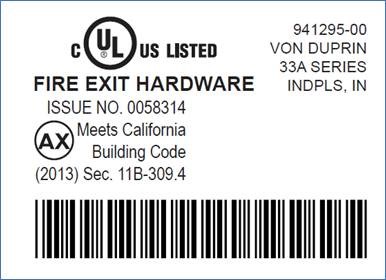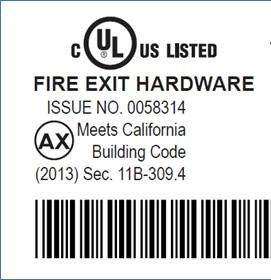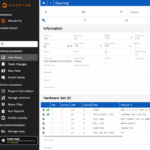When the 2010 edition of the ADA Standards for Accessible Design went into effect in 2012, they included a new requirement for door hardware to operate with 5 pounds of force or less. Although other codes require panic hardware to operate with 15 pounds of force or less, the ADA limit applied to all operable hardware – including panics. When California adopted the 2010 ADA standards for accessibility, the 5-pound requirement became applicable in California as part of the state building code. This is different from many other states, where ICC A117.1 is the accessibility standard referenced by the building code, and the ADA standards would typically apply to buildings after construction.

To ensure that panic hardware operates with 5 pounds of force or less, look for the certification indicating compliance with CBC (2013) Sec. 11B-309.4.
I recently learned of a project in California where the newly-installed panic hardware – approximately 60 devices – did not comply with the 5-pound limit. As I understand it, the options to rectify the problem were A) replace the existing (new) panic hardware with Von Duprin AX devices, which are UL-certified to operate with 5 pounds of force or less, or B) install automatic operators on the doors, so building occupants do not have to manually operate the panic hardware for egress. Option B would also require the panic hardware to have the electric latch retraction feature, and may require back-up power. Option A could require the replacement of fire doors because of the variations in the door prep between the two manufacturers.
I have heard of the 5-pound limit being enforced on some school projects in California, but this project is a healthcare facility. I also know of AHJs outside of California who have enforced the ADA requirement, so I wanted to give you all a heads-up. Replacing 60 panic devices or installing 60 automatic operators is something no one wants to deal with at the end of a project, whether you are a distributor, specifier, architect, contractor, or end user.
The video below explains the purpose of the Von Duprin AX device. I recorded it almost 5 years ago, but the information is still accurate.
You need to login or register to bookmark/favorite this content.






The AX devices were tested without a door closer correct?
Hi John –
Do you mean in the test lab or in the field?
– Lori
Test lab
Hi John –
The devices are tested as required by A156.3, except with the 5-pound limit established by the ADA standards. There is no closer on the test sample. Here is the applicable section from the BHMA standard:
8.2 Exit Tests
8.2.1 With the door latched, the actuating bar shall be depressed by a force not to exceed
15lbf. (67N)[5 lb] until the latch clears the strike. The measurement shall be taken at the center and 1.5 in. (38 mm) from each end on the actuating surface perpendicular to the door in the direction of swing. The actuating surface shall be visually and physically distinct from the rest of the device. Portions of the actuating bar which are below 30 in. (750mm) and more than 48 in. (1250mm) above the floor when installed per the manufacturer’s templating are exempt from this requirement.8.2.2 Using the setup and procedure in 8.2.1, apply a horizontal 250 lbf (1110 N) to the door approximately 3 in. (76 mm) from the latch edge and 40 in. (1020 mm) from the floor in the direction of the door swing. With the door latched, repeat the test in 8.2.1. The actuating bar shall be depressed by a force as listed below and the door swung open.
– Lori
As you know, there are competing requirements within these healthcare facilities, so I wonder which will take precedence. Can you share the healthcare facility?
Hi Michael –
I’d rather not share the name of the facility publicly since I don’t know who to ask for permission to do so, but the AHJ was an Inspector of Record (IOR) for the California Office of Statewide Health Planning and Development (OSHPD) in LA County.
– Lori
Understood. Can you share the specific application (ex. cross corridor, stairwell, entrance)? It will be interesting to understand if these openings fall within OSHPD’s 44″ clear requirements.
Hi Michael –
The panics were in different locations – stairwells, cross-corridor, suite entrances, etc.
– Lori
Lori, would a panic QEL with a motion sensor that retracts the latch as you approach the door help meet this requirement?
That’s a good question…it’s a pretty pricey solution, but I’d love to know what a California AHJ’s response would be. It would satisfy the intent of the code under normal operation, but it would require more than 5 pounds of force during a power failure. And if it was done on a fire door, it would require more than 5 pounds of force during a fire alarm.
– Lori
Does putting a door closer affect the lbs of pressure it takes on the panic hardware
Hi Steven –
The force to retract the latch should be measured separately from the force to open the door.
– Lori
Is there any other Exit device besides the Von Duprin AX that comply with the 5 lbs?
Hi Scot –
There is a Falcon AX model also.
– Lori